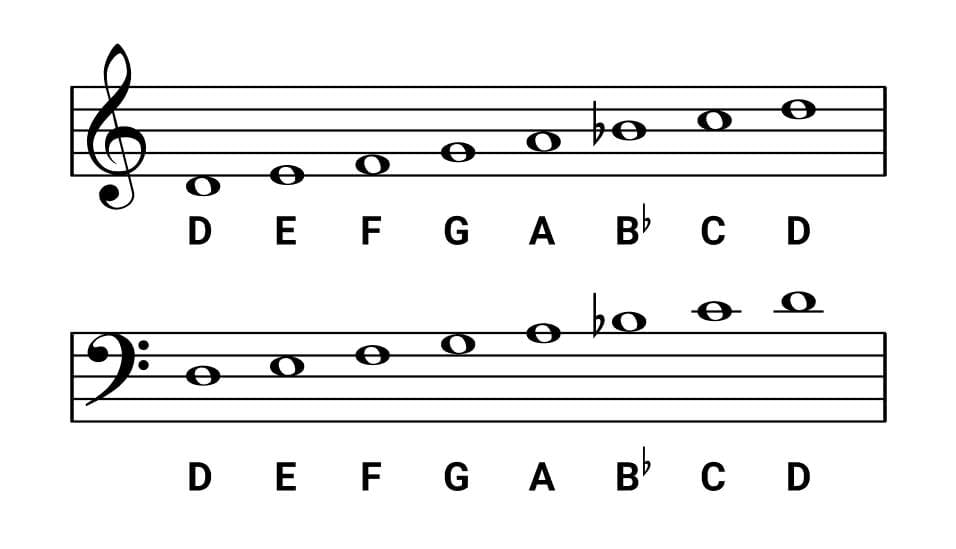How to Play the D minor scale on the Piano - Scales, Chords & Exercises
Jump to section
You get a fascinating chord poster + exclusive content!

The Notes of the D minor Scale
The D minor scale starts on D and includes one flat note. It uses the notes D-E-F-G-A-Bb-C-D. On the piano, you need to just play one black key: B-flat. For all of the other keys, you can use the white keys.

How to Play the D minor Scale With the Right Hand (Treble Clef)
On the piano, you can play the D minor scale going up (toward the higher notes), or coming down. In the treble clef, do this:
- Play the following notes going up: D-E-F-G-A-Bb-C-D. Start playing with your first finger, and tuck your thumb after you have played the third note to reach the G. As you continue playing the full hand, you will play the Bb with your third finger and the high D with your fifth finger.
- Play the following notes going down: D-C-Bb-A-G-F-E-D. Start playing with your fifth finger and play the full hand, then tuck your third finger over the thumb to play the F and continue until your first finger reaches the D.

How to Play the D minor Scale With the Left Hand (Bass Clef)
Piano beginners may find it difficult to read and play the left hand. It is worth investing some time to really familiarize yourself with the notes of the D minor scale in the bass clef, and learn how to read them in music scores.
The notes are the same as in the right hand (D-E-F-G-A-Bb-C-D), but they look different:

How to play D minor with the left hand
- Going up: Starting with your fifth finger (the pinkie) play the full hand, then tuck your third finger over the thumb to reach the Bb. Then continue playing to reach the high D.
- Coming down: Start with your first finger. After the first three notes, when you have reached the Bb, tuck your thumb under to reach the A, then play the full hand back down to D.
The D minor Key Signature
The key signature, located at the beginning of each line of a piece, lets you see which notes will be raised (#) or lowered (b) consistently throughout that piece.
If you spot this key signature below, the piece is likely in D minor (or in its parallel major scale F Major, you'll be able to determine that from the "minor" or "major" mood of the piece):

6 Exercises to Practice the D Minor Scale
Play one exercise after the other and only move on after having correctly played the previous exercise 5 times on your piano:
- Play the left hand up and down using a metronome and slowly increasing speed
- Play the right hand up and down using a metronome and slowly increasing speed
- Play both hands up and down using a metronome and slowly increasing speed
- Play the left hand up starting from the lowest D to the highest, and down starting from the highest D to the lowest
- Play the right hand up starting from the lowest D to the highest, and down starting from the highest D to the lowest
- Play both hands up starting with the left hand on the lowest D and stopping when the right hand reaches the highest D, then play down to the starting position
Why you should exercise scales in general:
- To memorize a scale
- To practice dexterity and intonation (play all keys with even loudness. Beginners often play the notes they work with their stronger fingers much harder. Aim for an even tone)
- To be able to play the scale in time without hesitating to find your fingerings
- To be able to build chords and improvise
D minor Chords on the Piano
A minor chord is constructed of three or more notes: The root note - the minor third - the perfect fifth.
In short, this tells us for D minor:
- The basic D minor chord consists of D-F-A.
- The first inversion is F-A-D.
- The second inversion is A-D-F.
To practice the D minor chord and inversions, switch from the chord starting with the root note to the first, and the second inversion, starting slowly using a metronome, then increasing your tempo.
10 Beautiful Pieces in D minor
- 1 City Of Stars: Justin Hurwitz
- 2 Concerto in D Minor, BWV 974: 2. Adagio: Johann Sebastian Bach
- 3 Bella Ciao: Anonymous
- 4 Ständchen (Serenade) D. 957 No. 4: Franz Schubert
- 5 The Scientist: Coldplay
- 6 Toccata and Fugue in D Minor, BWV 565: Johann Sebastian Bach
- 7 Requiem in D Minor, KV 626: Lacrimosa: Wolfgang Amadeus Mozart
- 8 Sonata quasi una Fantasia ("Moonlight Sonata"), Op. 27 No. 2: No. 1 Adagio: Ludwig van Beethoven
- 9 Up Is Down: Hans Zimmer
- 10 Habanera: Georges Bizet


